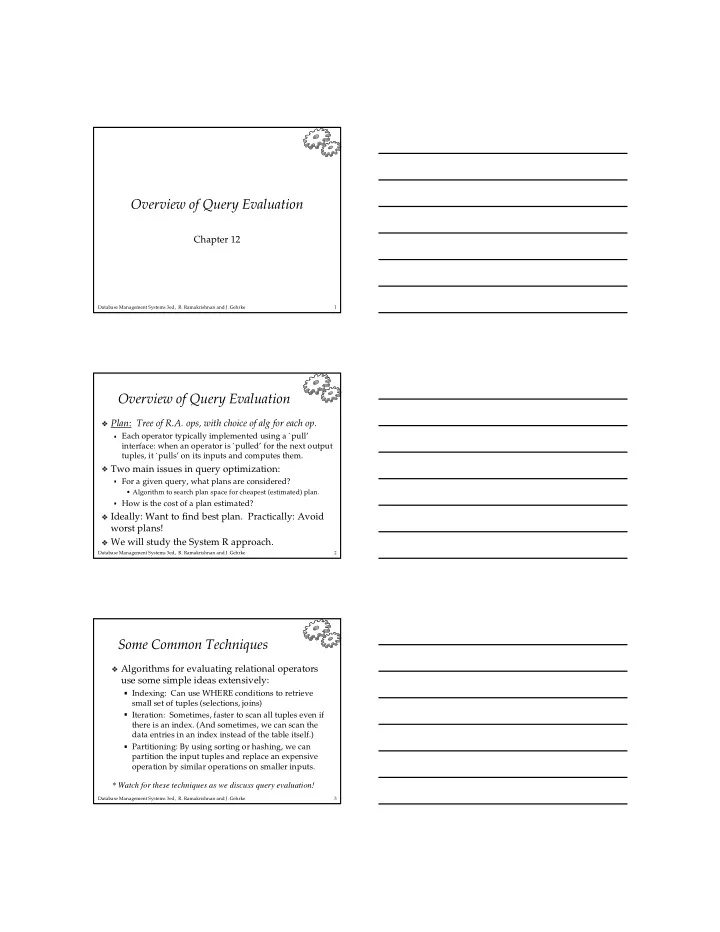

� � ✂ ✂ ✂ � � ✁ ✁ ✁ � Overview�of�Query�Evaluation Chapter�12 Database�Management�Systems�3ed,��R.�Ramakrishnan�and�J.�Gehrke 1 Overview�of�Query�Evaluation Plan : Tree�of�R.A.�ops,�with�choice�of alg for�each�op. Each�operator�typically�implemented�using�a�`pull’� interface:�when�an�operator�is�`pulled’�for�the�next�output tuples,�it�`pulls’�on�its�inputs�and�computes�them. Two�main�issues�in�query�optimization: For�a�given�query,�what�plans�are�considered? • Algorithm�to�search�plan�space�for�cheapest�(estimated)�plan. How�is�the�cost�of�a�plan�estimated? Ideally:�Want�to�find�best�plan.��Practically:�Avoid� worst�plans! We�will�study�the�System�R�approach. Database�Management�Systems�3ed,��R.�Ramakrishnan�and�J.�Gehrke 2 Some�Common�Techniques Algorithms�for�evaluating�relational�operators� use�some�simple�ideas�extensively: Indexing: Can�use�WHERE�conditions�to�retrieve� small�set�of tuples (selections,�joins) Iteration: Sometimes,�faster�to�scan�all tuples even�if� there�is�an�index.�(And�sometimes,�we�can�scan�the� data�entries�in�an�index�instead�of�the�table�itself.) Partitioning: By�using�sorting�or�hashing,�we�can� partition�the�input tuples and�replace�an�expensive� operation�by�similar�operations�on�smaller�inputs. *�Watch�for�these�techniques�as�we�discuss�query�evaluation! Database�Management�Systems�3ed,��R.�Ramakrishnan�and�J.�Gehrke 3
� � ✁ � ✂ � � � � ✁ ✁ ✁ ✁ � ✁ Statistics�and�Catalogs Need�information�about�the�relations�and�indexes� involved.�� Catalogs typically�contain�at�least: # tuples (NTuples)�and�#�pages�(NPages)�for�each�relation. #�distinct�key�values�(NKeys)�and NPages for�each�index. Index�height,�low/high�key�values�(Low/High)�for�each� tree�index. Catalogs�updated�periodically. Updating�whenever�data�changes�is�too�expensive;�lots�of� approximation�anyway,�so�slight�inconsistency�ok. More�detailed�information�(e.g.,�histograms�of�the� values�in�some�field)�are�sometimes�stored. Database�Management�Systems�3ed,��R.�Ramakrishnan�and�J.�Gehrke 4 Access�Paths An�access�path is�a�method�of�retrieving tuples: File�scan,�or�index that�matches a�selection�(in�the�query)� A�tree�index� matches (a�conjunction�of)�terms�that� involve�only�attributes�in�a� prefix of�the�search�key. E.g.,�Tree�index�on�< a,�b,�c >��matches�the�selection a=5� AND b=3 ,�and� a=5� AND b>6 ,�but�not b=3 . A�hash�index� matches (a�conjunction�of)�terms�that� has�a�term� attribute�=�value for�every�attribute�in�the� search�key�of�the�index. E.g.,�Hash�index�on�< a,�b,�c >��matches� a=5� AND b=3� AND c=5 ;�but�it�does�not�match b=3,�or a=5� AND b=3,�or a>5� AND b=3� AND c=5 . Database�Management�Systems�3ed,��R.�Ramakrishnan�and�J.�Gehrke 5 A�Note�on�Complex�Selections (day<8/9/94� AND rname=‘Paul’)� OR bid=5� OR sid=3 Selection�conditions�are�first�converted�to� conjunctive� normal�form� (CNF):��������������������� (day<8/9/94� OR bid=5� OR sid=3�)� AND (rname=‘Paul’� OR bid=5� OR sid=3)� We�only�discuss�case�with�no ORs;�see�text�if�you�are� curious�about�the�general�case. Database�Management�Systems�3ed,��R.�Ramakrishnan�and�J.�Gehrke 6
✂ ✁ ✁ � � � � ✁ ✁ � � ✁ One�Approach�to�Selections Find�the� most�selective�access�path ,�retrieve tuples using� it,�and�apply�any�remaining�terms�that�don’t�match the�index: Most�selective�access�path:� An�index�or�file�scan�that�we� estimate�will�require�the�fewest�page�I/Os. Terms�that�match�this�index�reduce�the�number�of tuples retrieved ;�other�terms�are�used�to�discard�some�retrieved tuples,�but�do�not�affect�number�of tuples/pages�fetched. Consider� day<8/9/94�AND�bid=5�AND sid=3. A�B+�tree� index�on� day� can�be�used;�then,� bid=5 and sid=3� must�be� checked�for�each�retrieved tuple.��Similarly,�a�hash�index�on� < bid, sid >�could�be�used;� day<8/9/94 must�then�be�checked. Database�Management�Systems�3ed,��R.�Ramakrishnan�and�J.�Gehrke 7 Using�an�Index�for�Selections Cost�depends�on�#qualifying tuples,�and� clustering. Cost�of�finding�qualifying�data�entries�(typically�small)� plus�cost�of�retrieving�records�(could�be�large�w/o� clustering). In�example,�assuming�uniform�distribution�of�names,� about�10%�of tuples qualify�(100�pages,�10000 tuples).�� With�a�clustered�index,�cost�is�little�more�than�100�I/Os;� if unclustered, upto 10000�I/Os! SELECT * Reserves�R FROM WHERE R.rname <�‘C%’ Database�Management�Systems�3ed,��R.�Ramakrishnan�and�J.�Gehrke 8 SELECT DISTINCT Projection R.sid,�R.bid Reserves�R FROM The�expensive�part�is�removing�duplicates. SQL�systems�don’t�remove�duplicates�unless�the�keyword� DISTINCT�is�specified�in�a�query. Sorting�Approach:��Sort�on�<sid,�bid>�and�remove� duplicates.�(Can�optimize�this�by�dropping�unwanted� information�while�sorting.) Hashing�Approach:�Hash�on�<sid,�bid>�to�create� partitions.��Load�partitions�into�memory�one�at�a� time,�build�in-memory�hash�structure,�and�eliminate� duplicates. If�there�is�an�index�with�both�R.sid and�R.bid�in�the� search�key,�may�be�cheaper�to�sort�data�entries! Database�Management�Systems�3ed,��R.�Ramakrishnan�and�J.�Gehrke 9
✁ � ✁ ✁ ✁ � ✁ � ✁ ✁ � � � ✁ � � ✁ Join:�Index�Nested�Loops foreach�tuple r�in�R�do foreach�tuple s�in�S�where r i == s j do add�<r,�s>�to�result If�there�is�an�index�on�the�join�column�of�one�relation� (say�S),�can�make�it�the�inner�and�exploit�the�index. Cost:��M�+�(�(M*p R )�*�cost�of�finding�matching�S tuples)� For�each�R tuple,�cost�of�probing�S�index�is�about�1.2� for�hash�index,�2-4�for�B+�tree.��Cost�of�then�finding�S tuples (assuming�Alt.�(2)�or�(3)�for�data�entries)� depends�on�clustering. Clustered�index:��1�I/O�(typical), unclustered: upto 1�I/O� per�matching�S tuple. Database�Management�Systems�3ed,��R.�Ramakrishnan�and�J.�Gehrke 10 Examples�of�Index�Nested�Loops Hash-index�(Alt.�2)�on sid of�Sailors�(as�inner): Scan�Reserves:��1000�page�I/Os,�100*1000 tuples. For�each�Reserves tuple:��1.2�I/Os�to�get�data�entry�in� index,�plus�1�I/O�to�get�(the�exactly�one)�matching�Sailors tuple.��Total:��220,000�I/Os. Hash-index�(Alt.�2)�on sid of�Reserves�(as�inner): Scan�Sailors:��500�page�I/Os,�80*500 tuples. For�each�Sailors tuple:��1.2�I/Os�to�find�index�page�with� data�entries,�plus�cost�of�retrieving�matching�Reserves tuples.��Assuming�uniform�distribution,�2.5�reservations� per�sailor�(100,000�/�40,000).��Cost�of�retrieving�them��is�1�or 2.5�I/Os�depending�on�whether�the�index�is�clustered. Database�Management�Systems�3ed,��R.�Ramakrishnan�and�J.�Gehrke 11 Join:�Sort-Merge�(R�����S) i=j Sort�R�and�S�on�the�join�column,�then�scan�them�to�do� a�``merge’’�(on�join�col.),�and�output�result tuples. Advance�scan�of�R�until�current�R-tuple >=�current�S tuple,� then�advance�scan�of�S�until�current�S-tuple >=�current�R tuple;�do�this�until�current�R tuple =�current�S tuple. At�this�point,�all�R tuples with�same�value�in Ri ( current�R� group )�and�all�S tuples with�same�value�in Sj ( current�S� group )� match ;��output�<r,�s>�for�all�pairs�of�such tuples. Then�resume�scanning�R�and�S. R�is�scanned�once;�each�S�group�is�scanned�once�per� matching�R tuple.��(Multiple�scans�of�an�S�group�are� likely�to�find�needed�pages�in�buffer.) Database�Management�Systems�3ed,��R.�Ramakrishnan�and�J.�Gehrke 12
Recommend
More recommend